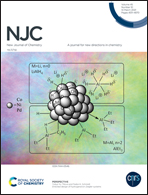Highly effective catalytic reduction of nitrobenzene compounds with gold nanoparticle-immobilized hydroxyapatite nanowire-sintered porous ceramic beads†
Abstract
The development of high-performance catalysts for eliminating the negative effects of hazardous contaminants is highly desirable. In this study, a nanogold-immobilized catalyst based on hydroxyapatite nanowire (HN)-sintered porous ceramic beads with excellent catalytic performance in the reductive degradation of nitrobenzene compounds has been prepared. The high-aspect-ratio HN self-assembles into a network structure and acts as a building block for forming the porous ceramic beads with an interconnected porous architecture and high porosity features. The ceramic skeleton with enriched anchoring sites can offer enough traction to disperse the stable gold nanoparticles (AuNPs) during the catalytic reaction process. The prepared HN/AuNP beads are analyzed by several characterization methods and demonstrate unique properties, such as micron-sized and interconnected porous channels, adjustable porosity, and good distribution of AuNPs. In addition, the HN/AuNP beads exhibit high catalytic activity in the reductive degradation of 4-nitrophenol by sodium borohydride. The HN/AuNP beads can be recycled, retaining their original conversion efficiency at about 97% even after 15 consecutive reaction cycles. Besides, the HN/AuNP beads maintain high catalytic stabilities after several high-temperature heat treatment procedures. Furthermore, the highly effective catalytic reduction conversion of several nitrobenzene compounds into the corresponding amino derivatives is achieved. The developed porous ceramic beads can be used for supporting various nanocatalysts. These results demonstrate that the catalytic porous beads are promising for applications in water treatment and high-temperature catalysis fields.



 Please wait while we load your content...
Please wait while we load your content...